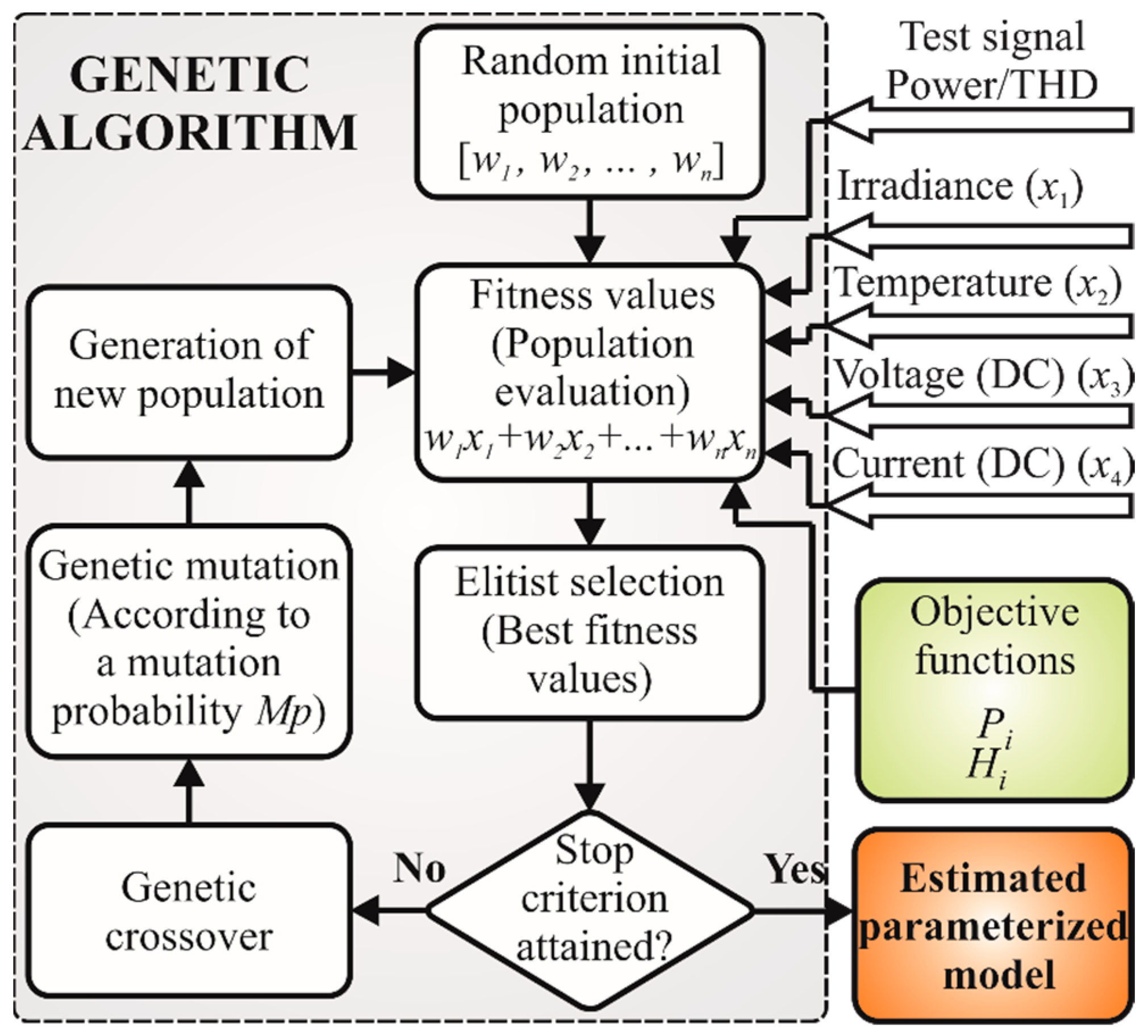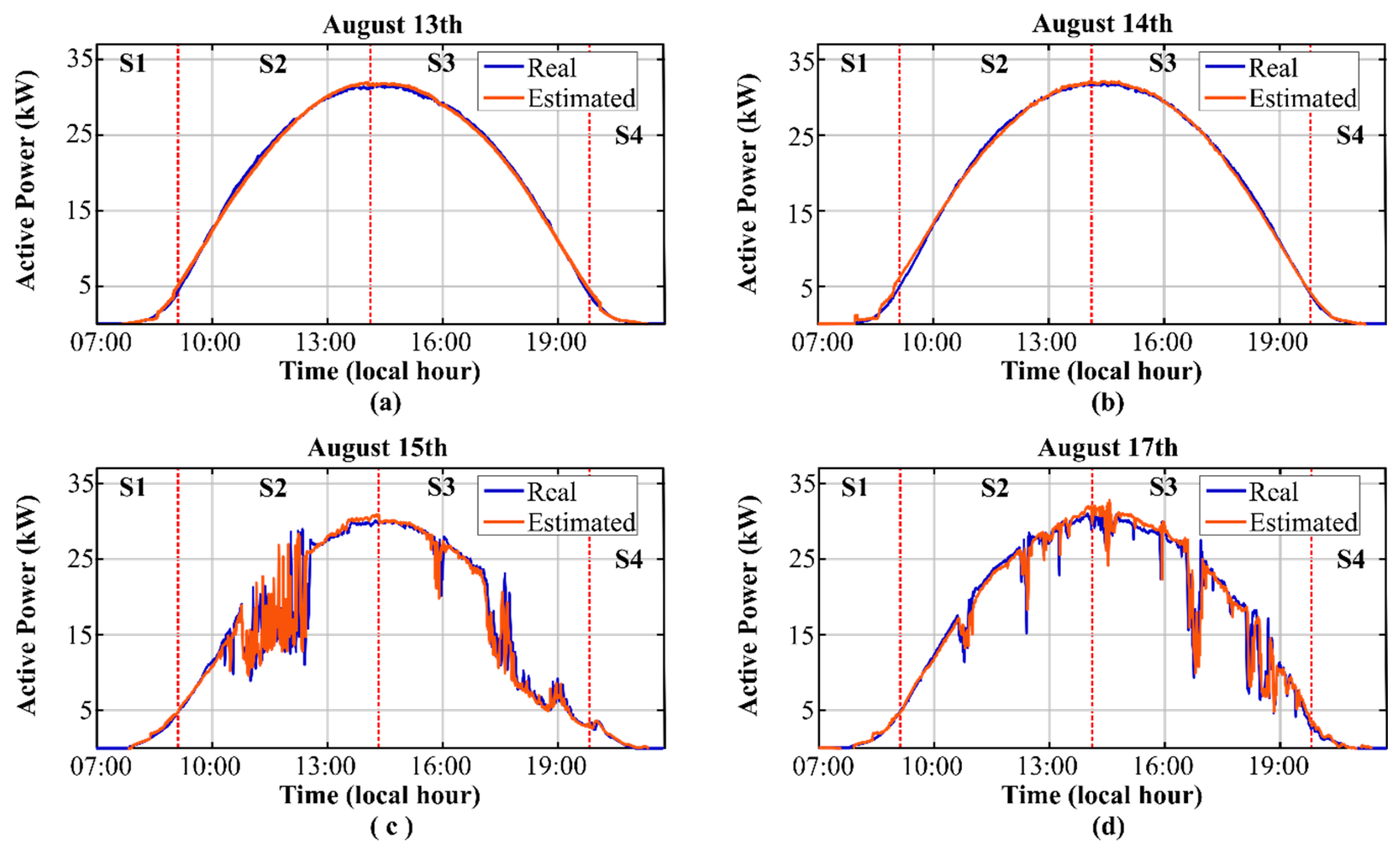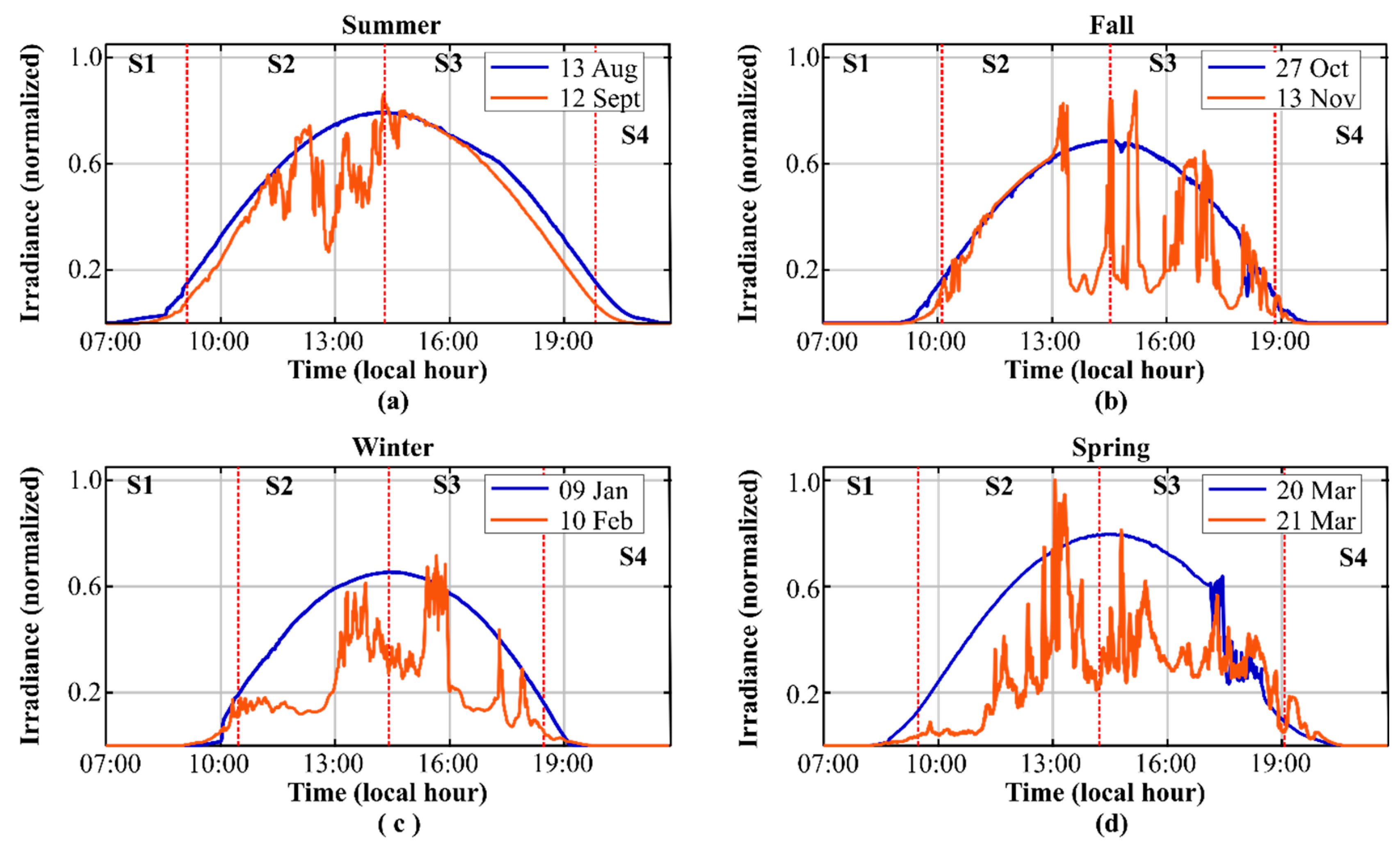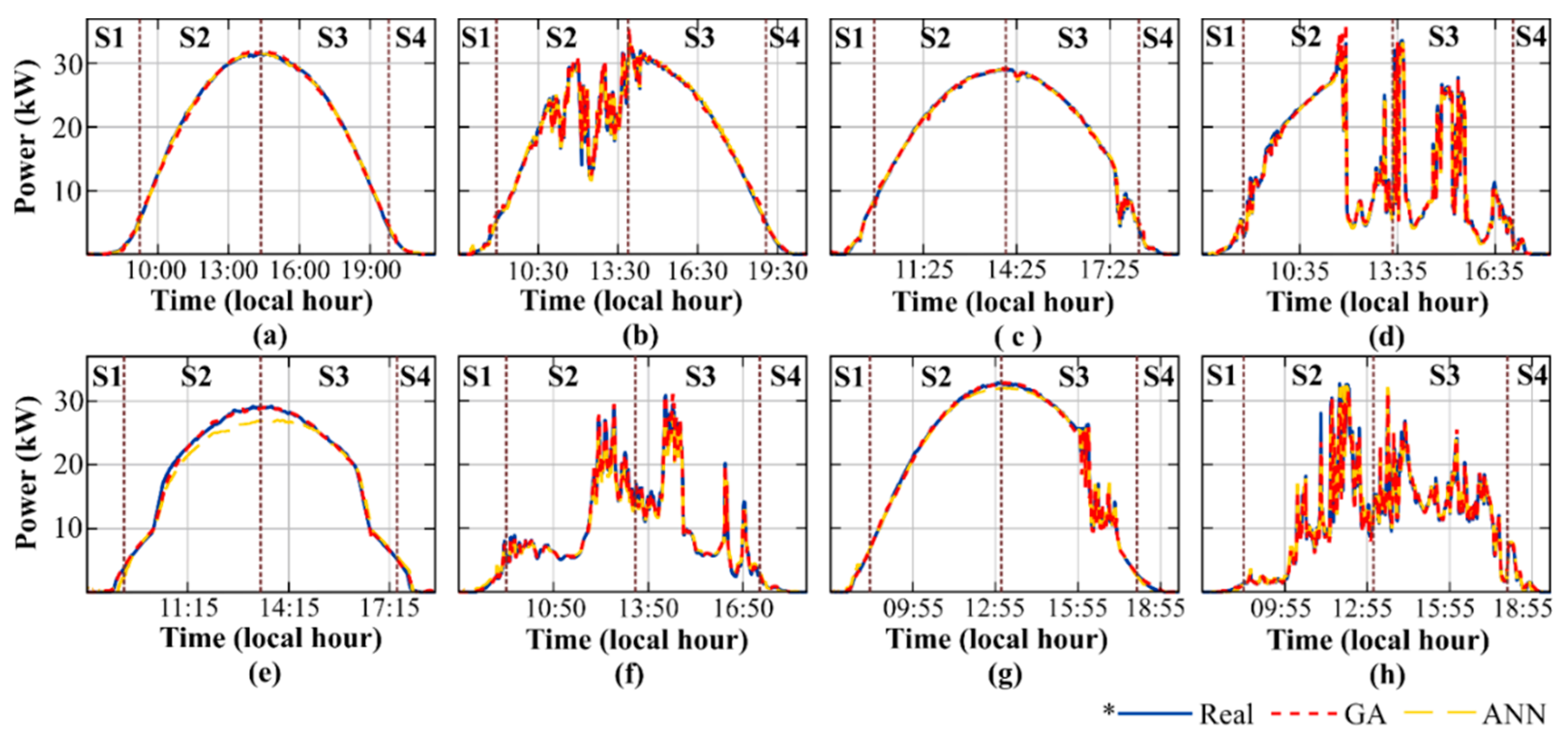Genetic Algorithm Methodology for the Estimation of Generated Power and Harmonic Content in Photovoltaic Generation
Abstract
1. Introduction
2. Theoretical Background
2.1. Active Power Definition
2.2. Total Harmonic Distortion (THD)
2.3. Evolutionary-Based Algorithm
3. Methodology
3.1. Parameterization Dataset and Experimentation Dataset
3.2. Genetic Algorithm for the Parameter Estimation
- is the i-th value of the sun irradiance;
- is the i-th value of the cell temperature;
- is the i-th value of the DC voltage signal;
- is the i-th value of the DC current signal; and
- , , , and are constant weights determined by the GA.
- is the i-th individual of the old population;
- is the best fitting individual; and
- is the i-th individual of the new population.
- is the i-th value of the sun irradiance;
- is the i-th value of the cell temperature;
- is the i-th value of the DC voltage signal;
- is the i-th value of the DC current signal;
- ;
- ;
- ;
- ;
- ;
- ;
- ;
- ;
- ;
- ; and
3.3. Piecewise Approach of the Proposed Methodology
4. Experimental Setup
5. Results and Discussion
5.1. Parameterization Results
5.2. Experimentation Results
6. Conclusions
Author Contributions
Funding
Conflicts of Interest
References
- Kim, J.; Park, B.S.; Park, Y.U. Flooding Message Mitigation of Wireless Content Centric Networking for Last-Mile Smart-Grid. Appl. Sci. Basel 2019, 9, 3978. [Google Scholar] [CrossRef]
- Renewable energy Policy Network for the 21st century. In Renewables 2018 Global Status Report; REN21: Paris, France, 2018.
- Thang, T.V.; Ahmed, A.; Kim, C.; Park, J. Flexible System Architecture of Stand-Alone PV Power Generation with Energy Storage Device. IEEE Trans. Energy Convers. 2015, 30, 1386–1396. [Google Scholar] [CrossRef]
- Jazayeri, M.; Jazayeri, K.; Uysal, S. Adaptive photovoltaic array reconfiguration based on real cloud patterns to mitigate effects of non-uniform spatial irradiance profiles. Sol. Energy 2017, 155, 506–516. [Google Scholar] [CrossRef]
- Mithulananthan, N.; Kumar Saha, T.; Chidurala, A. Harmonic impact of high penetration photovoltaic system on unbalanced distribution networks—Learning from an urban photovoltaic network. IET Renew. Power Gener. 2016, 10, 485–494. [Google Scholar]
- Sun, Y.; Li, S.; Lin, B.; Fu, X.; Ramezani, M.; Jaithwa, I. Artificial Neural Network for Control and Grid Integration of Residential Solar Photovoltaic Systems. IEEE Trans. Sustain. Energy 2017, 8, 1484–1495. [Google Scholar] [CrossRef]
- Aziz, T.; Ahmed, M.; Masood, N.A. Investigation of harmonic distortions in photovoltaic integrated industrial microgrid. J. Renew. Sustain. Energy 2018, 10, 053507. [Google Scholar] [CrossRef]
- Su, T.; Yang, M.; Jin, T.; Flesch, R.C.C. Power harmonic and interharmonic detection method in renewable power based on Nuttall double-window all-phase FFT algorithm. IET Renew. Power Gen. 2018, 12, 953–961. [Google Scholar] [CrossRef]
- Aiello, M.; Cataliotti, A.; Nuccio, S. A Chirp-Z Transform-Based Synchronizer for Power System Measurements. IEEE Trans. Instrum. Meas. 2005, 54, 1025–1032. [Google Scholar] [CrossRef]
- Melo, I.D.; Pereira, J.L.R.; Variz, A.M.; Garcia, P.A.N. Harmonic state estimation for distribution networks using phasor measurement units. Electr. Power Syst. Res. 2017, 147, 133–144. [Google Scholar] [CrossRef]
- Singh, S.K.; Sinha, N.; Goswami, A.K.; Sinha, N. Several variants of Kalman Filter algorithm for power system harmonic estimation. Int. J. Electr. Power Energy Syst. 2016, 78, 793–800. [Google Scholar] [CrossRef]
- Tiwari, V.K.; Jain, S.K. Hardware Implementation of Polyphase-Decomposition-Based Wavelet Filters for Power System Harmonics Estimation. IEEE Trans. Instrum. Meas. 2016, 65, 1585–1595. [Google Scholar] [CrossRef]
- Ahmad, M.W.; Mourshed, M.; Rezgui, Y. Tree-based ensemble methods for predicting PV power generation and their comparison with support vector regression. Energy 2018, 164, 465–474. [Google Scholar] [CrossRef]
- Wang, Y.; Hu, Q.; Meng, D.; Zhu, P. A review on the selected applications of forecasting models in renewable power systems. Renew. Sustain. Energy Rev. 2019, 100, 9–21. [Google Scholar]
- Wang, Y.; Hu, Q.; Meng, D.; Zhu, P. Deterministic and probabilistic wind power forecasting using a variational Bayesian-based adaptive robust multi-Kernel regression model. Appl. Enery 2017, 208, 1097–1112. [Google Scholar] [CrossRef]
- Shi, J.; Lee, W.J.; Liu, Y.; Yang, Y.; Wang, P. Forecasting power output of photovoltaic systems based on weather classification and support vector machines. IEEE Trans. Ind. Appl. 2012, 48, 1064–1069. [Google Scholar] [CrossRef]
- Yang, H.T.; Huang, C.M.; Huang, Y.C.; Pai, Y.S. A Weather-Based Hybrid Method for 1-Day Ahead Hourly Forecasting of PV Power Output. IEEE Trans. Sustain. Energy 2014, 5, 917–926. [Google Scholar] [CrossRef]
- Rodrigues, E.; Gomes, A.; Gaspar, A.R.; Antunes, C.H. Estimation of renewable energy and built environment-related variables using neural networks—A review. Renew. Sustain. Energy Rev. 2018, 94, 959–988. [Google Scholar] [CrossRef]
- Benali, L.; Notton, G.; Fouilloy, A.; Voyant, C.; Dizene, R. Solar radiation forecasting using artificial neural network and random forest methods: Application to normal beam, horizontal diffuse and global components. Renew. Energy 2019, 132, 871–884. [Google Scholar] [CrossRef]
- Yoza, A.; Uchida, K.; Chakraborty, S.; Krishna, N.; Kinjo, M.; Senjyu, T.; Yan, Z. Optimal Scheduling Method of Controllable Loads in Smart Home Considering Re-Forecast and Re-Plan for Uncertainties. Appl. Sci. Basel 2019, 9, 4064. [Google Scholar] [CrossRef]
- Li, H.; Yang, D.; Su, W.; Lü, J.; Yu, X. An overall distribution Particle Swarm Optimization MPPT algorithm for photovoltaic system under partial shading. IEEE Trans. Ind. Electron. 2019, 66, 265–275. [Google Scholar] [CrossRef]
- Sundareswaran, K.; Vigneshkumar, V.; Sankar, P.; Simon, S.P.; Srinivasa, P.; Nayak, R.; Palani, S. Development of an improved P&O algorithm assisted through a Colony of Foraging Ants for MPPT in PV system. IEEE Trans. Ind. Informat. 2016, 12, 187–200. [Google Scholar]
- Lyden, S.; Haque, M.E. A Simulated Annealing Global Maximum Power Point Tracking approach for PV modules under Partial Shading Conditions. IEEE Trans. Power Electron. 2016, 31, 4171–4181. [Google Scholar] [CrossRef]
- Liu, N.; Chen, Q.; Liu, J.; Lu, X.; Li, P.; Lei, J.; Zhang, J. A heuristic operation strategy for commercial building microgrids containing EVs and PV System. IEEE Trans. Ind. Electron. 2015, 62, 2560–2570. [Google Scholar] [CrossRef]
- Omar, A.; Hasanien, H.M.; Elgendy, M.A.; Badr, M.A.L. Identification of the photovoltaic model parameters using the crow search algorithm. J. Eng. 2017, 2017, 1570–1575. [Google Scholar] [CrossRef]
- Elazab, O.S.; Hasanien, H.M.; Elgendy, M.A.; Abdeen, A.M. Whale optimisation algorithm for photovoltaic model identification. J. Eng. 2017, 2017, 1906–1911. [Google Scholar] [CrossRef]
- IEEE Standard Definitions for the Measurement of Electric Power Quantities under Sinusoidal, Nonsinusoidal, Balanced, or Unbalanced Conditions; IEEE standard: Piscataway, NJ, USA, 2010; No. 1459.
- IEEE Recommended Practice and Requirements for Harmonic Control in Electric Power Systems; IEEE standard: Piscataway, NJ, USA, 2014; No. 519.
- Rodriguez-Guerrero, M.A.; Jaen-Cuellar, A.Y.; Carranza-Lopez-Padilla, R.D.; Osornio-Rios, R.A.; Herrera-Ruiz, G.; Romero-Troncoso, R.D.J. Hybrid Approach Based on GA and PSO for Parameter Estimation of a Full Power Quality Disturbance Parameterized Model. IEEE Trans. Ind. Informat. 2018, 14, 1016–1028. [Google Scholar] [CrossRef]
- Rao, S.S. Engineering Optimization Theory and Practice, 4th ed.; John Wiley & Sons Inc.: Coral Gables, FL, USA, 2009; pp. 693–730. [Google Scholar]
- Howlader, A.M.; Sadoyama, S.; Roose, L.R.; Sepasi, S. Experimental analysis of active power control of the PV system using smart PV inverter for the smart grid system. In Proceedings of the IEEE 12th International Conference on Power Electronics and Drive Systems (PEDS), Honolulu, HI, USA, 12–15 December 2017; pp. 497–501. [Google Scholar]
- Sudiarto, B.; Zahra, A.; Jufri, F.H.; Ardita, I.M.; Hudaya, C. Characteristics of Disturbance in Frequency 9 -150 kHz of Photovoltaic System under Fluctuated Solar Irradiance. In Proceedings of the IEEE 2nd International Conference on Power and Energy Applications (ICPEA), Singapore, 27–30 April 2019; pp. 217–221. [Google Scholar]
- Langella, R.; Testa, A.; Meyer, J.; Möller, F.; Stiegler, R.; Djokic, S.Z. Experimental-based evaluation of PV inverter harmonic and interharmonic distortion due to different operating conditions. IEEE Trans. Instrum. Meas. 2016, 65, 2221–2233. [Google Scholar] [CrossRef]





| Weight | S1 | S2 | S3 | S4 |
|---|---|---|---|---|
| w1 | 34.23 | 25.13 | 7.57 | −1.92 |
| w2 | 7.14 | −55.62 | 75.85 | −24.83 |
| w3 | −1.19 | 1.06 | −6.25 | 0.98 |
| w4 | −63.16 | 37.39 | 103.43 | 120.92 |
| Weight | S1 | S2 | S3 | S4 |
|---|---|---|---|---|
| u1 | −3.27 | −1.92 | 0.19 | 2.59 |
| u2 | 4.92 | 3.77 | −0.86 | 1.84 |
| u3 | 1.38 | 0.85 | −2.06 | −0.94 |
| u4 | −4.68 | 3.63 | −0.44 | 0.85 |
| u5 | 0.03 | −0.19 | −2.06 | −3.99 |
| u6 | 4.45 | −0.86 | 0.16 | −0.22 |
| u7 | −1.54 | 0.13 | 2.21 | −0.92 |
| u8 | 0.50 | 0.25 | 2.25 | −0.65 |
| u9 | −0.92 | −2.12 | −1.96 | −1.93 |
| u10 | −1.89 | −0.62 | −0.69 | −3.05 |
| u11 | 2.66 | 0.31 | −0.16 | −2.22 |
| u12 | −0.39 | −2.18 | 3.29 | 4.04 |
| u13 | −3.08 | −0.13 | 1.55 | −1.67 |
| u14 | −4.93 | 0.77 | 1.78 | −1.22 |
| Day | Estimated Error (%) | |||
|---|---|---|---|---|
| Active Power | THD (Total Harmonic Distortion) | |||
| GA (Genetic Algorithms) | ANN (Artificial Neural Network) | GA | ANN | |
| Aug 13th | 0.10 | 0.70 | 0.60 | 6.50 |
| Sep 12th | 0.44 | 0.50 | 0.22 | 3.30 |
| Oct 27th | 0.38 | 0.08 | 0.61 | 3.90 |
| Nov 13th | 0.34 | 1.40 | 1.10 | 3.20 |
| Jan 9th | 0.20 | 4.30 | 0.33 | 22.00 |
| Feb 10th | 0.07 | 2.90 | 0.08 | 16.00 |
| Mar 20th | 0.21 | 1.10 | 1.20 | 13.00 |
| Mar 21st | 0.71 | 0.70 | 1.10 | 33.40 |
© 2020 by the authors. Licensee MDPI, Basel, Switzerland. This article is an open access article distributed under the terms and conditions of the Creative Commons Attribution (CC BY) license (http://creativecommons.org/licenses/by/4.0/).
Share and Cite
Elvira-Ortiz, D.A.; Jaen-Cuellar, A.Y.; Morinigo-Sotelo, D.; Morales-Velazquez, L.; Osornio-Rios, R.A.; Romero-Troncoso, R.d.J. Genetic Algorithm Methodology for the Estimation of Generated Power and Harmonic Content in Photovoltaic Generation. Appl. Sci. 2020, 10, 542. https://doi.org/10.3390/app10020542
Elvira-Ortiz DA, Jaen-Cuellar AY, Morinigo-Sotelo D, Morales-Velazquez L, Osornio-Rios RA, Romero-Troncoso RdJ. Genetic Algorithm Methodology for the Estimation of Generated Power and Harmonic Content in Photovoltaic Generation. Applied Sciences. 2020; 10(2):542. https://doi.org/10.3390/app10020542
Chicago/Turabian StyleElvira-Ortiz, David A., Arturo Y. Jaen-Cuellar, Daniel Morinigo-Sotelo, Luis Morales-Velazquez, Roque A. Osornio-Rios, and Rene de J. Romero-Troncoso. 2020. "Genetic Algorithm Methodology for the Estimation of Generated Power and Harmonic Content in Photovoltaic Generation" Applied Sciences 10, no. 2: 542. https://doi.org/10.3390/app10020542
APA StyleElvira-Ortiz, D. A., Jaen-Cuellar, A. Y., Morinigo-Sotelo, D., Morales-Velazquez, L., Osornio-Rios, R. A., & Romero-Troncoso, R. d. J. (2020). Genetic Algorithm Methodology for the Estimation of Generated Power and Harmonic Content in Photovoltaic Generation. Applied Sciences, 10(2), 542. https://doi.org/10.3390/app10020542











